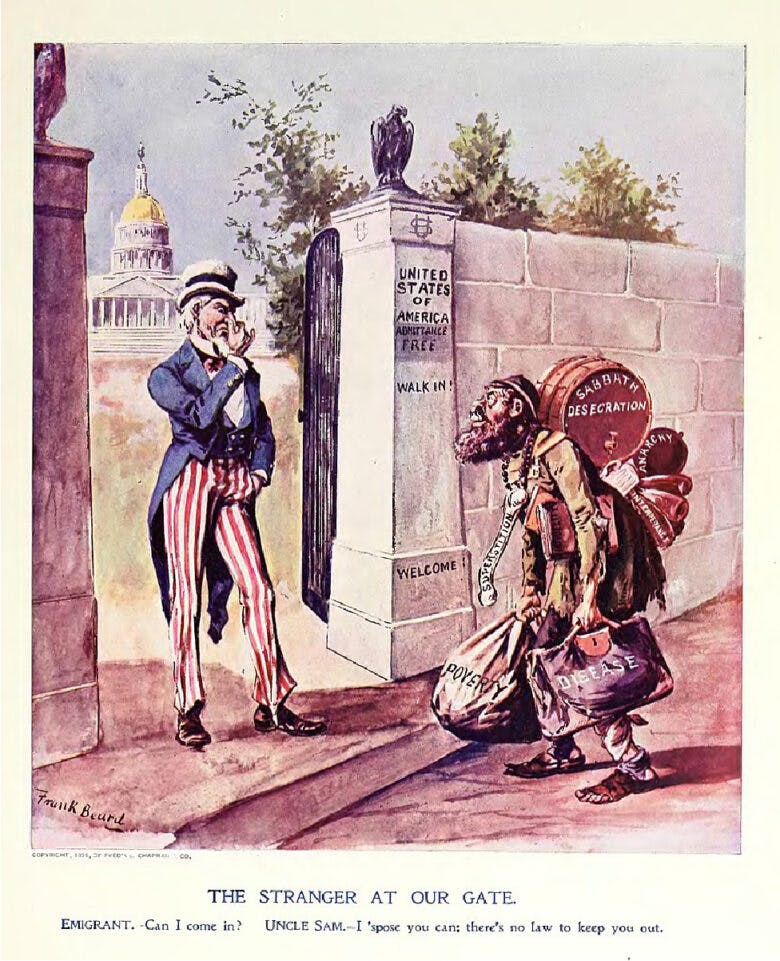Cartoon Analysis: Immigration in the Gilded Age, 1882–1896
Use this primary source imagery to analyze major events in history.
Suggested Sequencing
- Use this Primary Source with The Chinese Exclusion Act Decision Point to allow students to analyze the negative sentiment against Chinese immigrants during the late 1800s. It should also be used with the Industry and Immigration in the Gilded Age Lesson to highlight the way immigrants were regarded and treated during the Gilded Age.
Introduction
The late nineteenth century experienced one of the largest mass migrations in history. Millions of immigrants came to the United States from other parts of North America, as well as from Europe and Asia. Immigrants, who settled in the United States primarily for the economic opportunity afforded by industrialization, faced many challenges upon arriving. The influx of so many immigrants changed American culture and presented unique tensions in American society. This led to a debate among native citizens over immigration, citizenship, and the restriction of immigration. Immigrants arriving during the Gilded Age included large numbers of eastern Europeans and Asians. Cartoons from the period reflect differing perspectives on the new wave of immigrants. Some welcomed these men and women as a new source of cheap labor; others viewed these newcomers with suspicion. Look carefully at the images before answering the questions. It may be helpful to zoom in on the cartoons to study the detail in each.
Sourcing Questions
- What were the major events in the country at the time these cartoons were published?
- How were the immigrants regarded by American-born workers? How did many factory owners regard the influx of immigrants in the Gilded Age?

Figure 1: The caption reads: “The Anti-Chinese wall—The American wall goes up as the Chinese original goes down.” This cartoon shows stereotypes of laborers who include Irishmen, an African American, a Civil War veteran, an Italian, a Frenchman, and a Jew, all building a wall against the Chinese. The mortar used to mount the blocks is labeled “congressional mortar.” The blocks carried by each laborer are labeled prejudice, nonreciprocity, law against race, fear, and so forth. Across the sea, a ship flying the American flag enters China, as the Chinese knock down their own wall and permit trade with the United States.

Figure 2: The man standing at the edge of the bowl holds a knife and flag that reads “Clan na Gael.” Clan na Gael was an organization that desired Irish independence and used violence to fight British oppression. Until the formal establishment of the Irish free state in 1922, Ireland was controlled by the British empire.

Figure 3: Stereotyped Jewish immigrant is carrying bags that read “poverty,” “disease,” “sabbath desecration,” “anarchy,” and “superstition” as he attempts to enter the United States through a gate that reads “United States of America. Admittance Free. Walk in!”
Comprehension Questions
- (Figure 1) Based on this image, what was the prevailing view of the Chinese at the time this cartoon was created?
- (Figure 1) Does the artist support this view? Explain.
- (Figure 2) Based on this depiction of the Irishman, what was the artist’s opinion of the Irish people?
- (Figure 2) What additional image in this cartoon supports the artist’s view of the Irish?
- (Figure 1) (Figure 2) Compare this image with the previous cartoon, “The Anti-Chinese Wall” from 1882.
- (Figure 3) Explain the irony of the sign on the wall and Uncle Sam’s expression.
Historical Reasoning Questions
- Do these cartoons present immigrants in a positive or negative light? Support your answer with evidence.
- Evaluate how views of immigration have changed or stayed the same in U.S. history from the founding era to the Gilded Age. What parallels with the modern immigration debate can be identified? Explain.
Cartoon 1: http://cdn.loc.gov/service/pnp/cph/3g00000/3g04000/3g04100/3g04138v.jpg
Cartoon 2: https://commons.wikimedia.org/wiki/File:Mortar_of_Assimilation_Citizenship_1889.jpg
